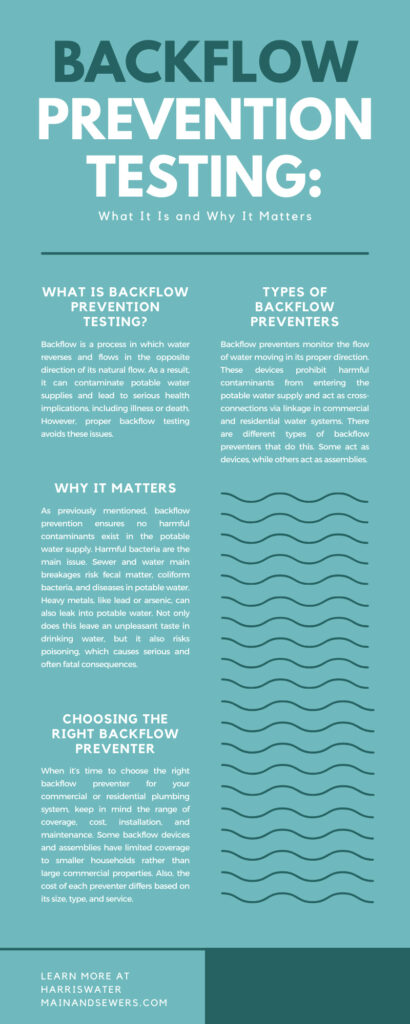You may think water naturally flows into your plumbing system, ready to use. While clean water enters your property, dirty water travels out to a water treatment facility. Still, water mains sometimes break, which can have devastating consequences. If you notice dirty water from your tap when it should be clean, you have a backflow issue. This occurs when the flow of water changes and contaminants ruin your clean water supply. Keep in mind this guide on backflow prevention testing: what it is and why it matters to avoid any serious health issues.
What Is Backflow Prevention Testing?
Backflow is a process in which water reverses and flows in the opposite direction of its natural flow. As a result, it can contaminate potable water supplies and lead to serious health implications, including illness or death. However, proper backflow testing avoids these issues.
There are two main reasons backflow occurs. The first is known as back siphonage. This occurs due to a drop in water pressure from a water main break. If an accident such as a broken fire hydrant disrupts a water main, the drop in water pressure could contaminate dirty water and lead to illness. Back siphonage is the most common cause of backflow. The cross-contamination affects the water supply, which leads to contamination.
The second reason backflow occurs is due to back pressure. This occurs when an increase in water pressure from the downstream pressure rises higher than the pressure of the water source. A clog or build-up in a water system contaminates water in the water system, which further affects pumps, boiler pressure, and storage tanks. Backflow prevention evaluates and assesses the situation to ensure no harmful contaminants collect in the water supply.
Types of Backflow Preventers
Backflow preventers monitor the flow of water moving in its proper direction. These devices prohibit harmful contaminants from entering the potable water supply and act as cross-connections via linkage in commercial and residential water systems. There are different types of backflow preventers that do this. Some act as devices, while others act as assemblies.
Backflow prevention devices stop the reversal flow in plumbing systems yet lack inlet shutoff valves or outlet shutoff valves. They also lack test valves, which makes it impossible to monitor or assess contamination levels. Atmospheric vacuum breakers are a common type of backflow prevention device that relies on air pressure to open an air inlet valve if reversal flow occurs. This air inlet valve further acts to prevent back siphonage.
Although they’re effective for commercial and residential plumbing systems, atmospheric vacuum breakers are not suitable for industrial applications. They cannot protect against chemical backflow if pesticides or fertilizers contaminate irrigation water, nor do they contain a shutoff valve. As such, back pressure remains a consistent issue.
Different Backflow Prevention Assemblies
Backflow prevention assemblies contain all inlet, outlet, and shutoff valves necessary for testing. The three most common backflow prevention assemblies include pressure vacuum breakers, spill-resistant vacuum breakers, and double check valves.
Pressure vacuum breakers (PVB) are perhaps the most common type of backflow prevention assembly. They are affordable, repairable, and easy to use. PVBs contain an inlet shutoff valve, pressure vacuum breaker, spring-loaded check valve to monitor the flow of water, test valve, and outlet shutoff valve. Still, PVBs cannot defend against back pressure, only back siphonage. They also cannot protect against chemical contamination but are still feasible for industrial applications.
Like PVBs, spill-resistant vacuum breakers (SVB) are another type of backflow prevention assembly that is perfect for indoor plumbing systems. They prevent water overflows to prevent back siphonage.
Double check valves (DCVA) are suitable for indoor and outdoor water systems. They contain an inlet shutoff valve, two spring-loaded, independent check valves, four test valves, and an outlet shutoff valve that protects against both back siphonage and back pressure. Whereas PVBs must be at least one foot above the highest downstream point, double check valves are suitable for underground systems as long as there’s one foot of clearance underneath for maintenance. Like the other backflow pressure assemblies, double check valves do not protect against chemical contamination and are best suited for low-hazard situations.
Why It Matters
With that in mind, there’s a lot at stake when it comes to backflow prevention testing: what it is and why it matters. As previously mentioned, backflow prevention ensures no harmful contaminants exist in the potable water supply. Harmful bacteria are the main issue. Sewer and water main breakages risk fecal matter, coliform bacteria, and diseases in potable water. This significantly increases the risk of salmonella, dysentery, and E. coli., which can cause gastrointestinal distress, fever, and sometimes death.
Heavy metals, like lead or arsenic, can also leak into potable water. Not only does this leave an unpleasant taste in drinking water, but it also risks poisoning, which causes serious and often fatal consequences. If it occurs near industrial water systems, backflow introduces the risk of chemical waste, such as fertilizers, pesticides, and insecticides, which also have negative health effects.
Choosing the Right Backflow Preventer
When it’s time to choose the right backflow preventer for your commercial or residential plumbing system, keep in mind the range of coverage, cost, installation, and maintenance. Some backflow devices and assemblies have limited coverage to smaller households rather than large commercial properties. Also, the cost of each preventer differs based on its size, type, and service. Cost-efficient preventers have a more limited capability than more expensive options. Finally, consider the installation and maintenance of each device or assembly. PVBs and SVBS are considerably easier to install and maintain than more complex solutions but cannot protect as efficiently as DCVAs or others.
If you suffer from a broken water main in New York City, there’s no better solution than Harris Water Main and Sewers. With over one hundred years of experience, we are the perfect solution for water main repairs in Brooklyn. At Harris Water Main and Sewers, we handle any size repair or replacement at an economical price. We’re licensed across Brooklyn, Queens, Manhattan, and the Bronx for any commercial and residential emergencies. We also offer 24/7 emergency repairs all year long. If you notice a leak, backflow, or broken water main, we’re the people to call.





















